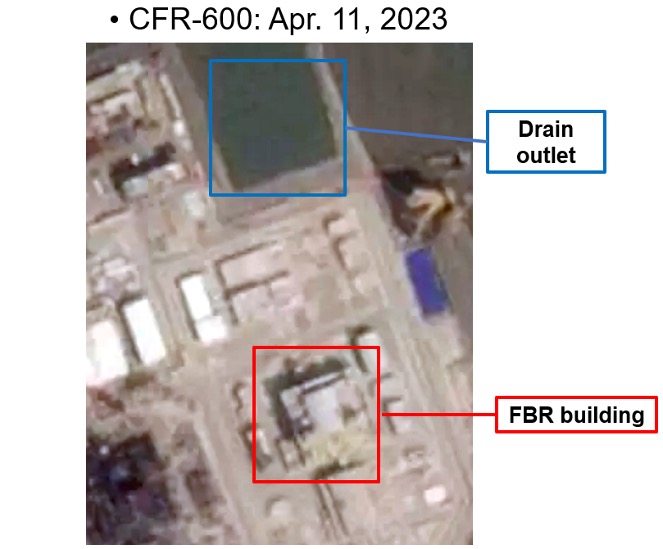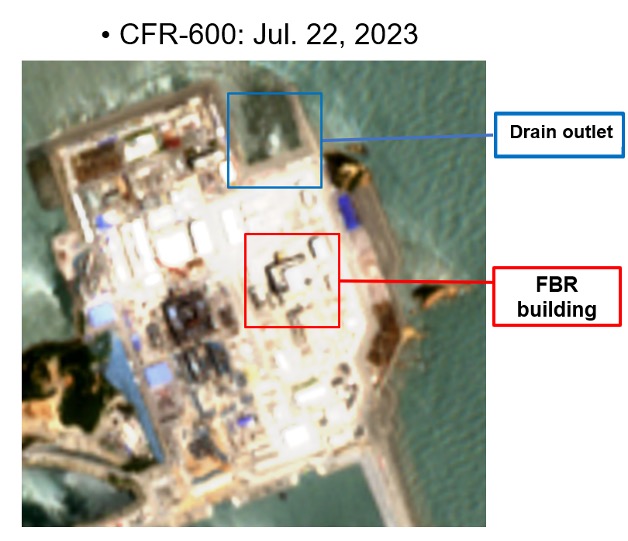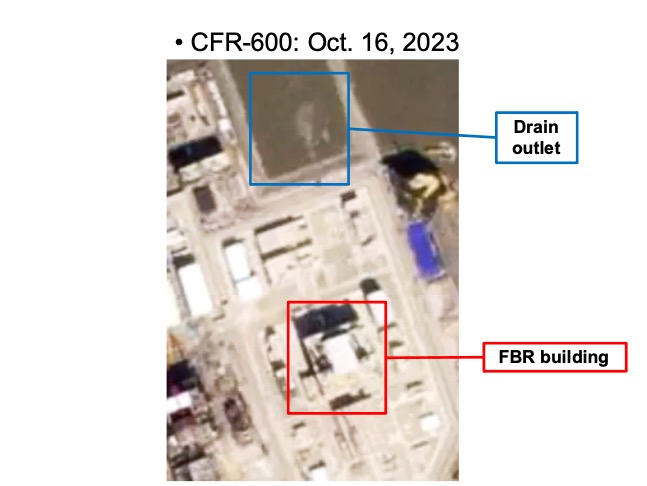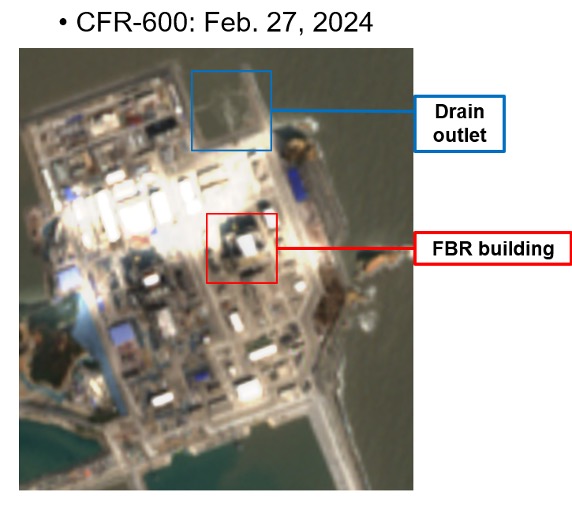Satellite Imagery Analysis 2024/05/27
Water Drainage Observed at China’s Fast Breeder Reactor
Full-Scale Operation Likely in Near Future
Yuki Kobayashi (Research Fellow, Sasakawa Peace Foundation)
1 The latest developments surrounding a fast breeder reactor in China
There are conflicting reports about a fast breeder reactor (FBR) that is being built along the coast of Fujian Province, China. By reprocessing spent fuel from FBRs, it is possible to extract a large amount of ultrapure plutonium-239, a material ideal for use in nuclear weapons. It has been pointed out that China may use this facility as a plutonium supply base as it moves to expand its nuclear arsenal to achieve a military power balance with the U.S. Sasakawa Peace Foundation has continuously analyzed satellite images of the facility and pointed to the possibility that it may start operation by the end of 2023. On the other hand, some officials related to the facility have testified that there is a delay in its operational plan [1].
Therefore, our foundation again analyzed developments surrounding the facility, including newly acquired satellite images, working with Hajime Matsukubo, Secretary General of Citizens’ Nuclear Information Center, who is involved in satellite imagery analysis, and Tomonori Iwamoto, Secretary General of the Institute of Nuclear Materials Management (INMM) Japan, who is familiar with the structure of FBRs. As a result, it was confirmed that a large amount of water had been drained out of the facility since last summer. A large amount of drainage means that the reactor’s temperature has risen, requiring seawater to be pumped in, circulated around the reactor and drained out for cooling. It can be assumed that this FBR has started a test operation.
This article aims to examine the current situation of China’s FBRs, noteworthy points and anticipated future developments based on new satellite images and other various data.
2. China’s plutonium stockpile and the likelihood of its nuclear arms expansion
In April 2024, the International Panel on Fissile Materials (IPFM), which studies global trends in nuclear materials, released the latest data on plutonium stockpiles by country (see Table 1).
Table 1: Plutonium stockpiles by country
| Country | Plutonium (Pu) Stockpile (ton) | Pu convertible to military use (ton) |
|---|---|---|
| Russia | 193 | 88 |
| U.S. | 87.6 | 38.4 |
| U.K. | 119.6 | 3.2 |
| France | 98 | 6 |
| China | 3 | 2.9 |
| Pakistan | 0.54 | 0.54 |
| India | 10 | 0.7 |
| Israel | 0.9 | 0.9 |
| North Korea | 0.04 | 0.04 |
Source: The International Panel on Fissile Materials (IPFM)
The 2023 edition of the U.S. Defense Department’s annual report to Congress about China’s military developments, Military and Security Developments Involving the People’s Republic of China, points out[2] that the number of China’s nuclear warheads has exceeded 500. The report estimates that the country will have “over 1,000 warheads by 2030,” considering its current plutonium stockpile and the possibility of its increasing plutonium production at FBRs, as described later. The New Strategic Arms Reduction Treaty (New START) signed between the two nuclear superpowers, the U.S. and Russia, sets the ceiling on the number of deployed warheads on both sides at 1,550. The Pentagon report indicates the possibility of China catching up with this number in the early 2030s.
However, it would not be feasible for any country to deploy all nuclear warheads it possesses in terms of the operation and management of nuclear weapons. The U.S. and Russia have more than 3,000 nondeployed nuclear warheads each. China has a smaller stockpile of plutonium convertible to military use than the U.K. and France, which have 225 and 290 nuclear warheads[3], respectively, fewer than China. Since one nuclear weapon is calculated to require 3.5 ± 0.5 kilograms of plutonium, China will not likely have more than 1,500 nuclear weapons at its current pace. If it aims to have as many nuclear weapons deployed as the U.S., it would be indispensable to increase its production of plutonium and build up nondeployed nuclear weapons. This is why the FBR in Fujian has received attention.
3. The current situation of the FBR in China based on satellite imagery analysis
According to a report from the International Atomic Energy Agency (IAEA), China began building an FBR named CFR-600 (with a capacity of 600 MW) in Fujian in 2017 [4]. On December 28, 2022, the Russian state-owned atomic energy corporation ROSATOM announced that it had delivered the initial fuel load necessary for the FBR’s operation to China [5]. In October 2023, Sasakawa Peace Foundation confirmed, based on the analysis of satellite images, that steam was coming out from a ventilation stack and concluded that the reactor was ready to start operation (refer to “China’s Fast Breeder Reactor Operating? Possibility of Accelerating Nuclear Arms Race”by Yuki Kobayashi). However, the Chinese government and China National Nuclear Corporation (CNNC), the FBR’s operator, have not revealed any information on CFR [6], and there is other information suggesting a delay in its operational plan. Accordingly, we decided to analyze satellite images again with experts.
Whether steam was coming out from the ventilation stack can be confirmed with high-quality, high-resolution images, which are difficult to acquire. This time, we focused on water drainage from the facility instead. To keep reactor facilities from reaching high temperatures, a nuclear power station, including those with an FBR, draws a large amount of water from a river or the sea, making it circulate through pipes and drain out for cooling. While the reactor is running, a substantial amount of water is constantly drained out from a large drain outlet, around which water whirls can clearly be identified in satellite pictures of average image quality. At the end of last year, the IAEA announced that an experimental reactor that was being built in Nyonbyon, North Korea, showed signs of starting operation [7], citing drained water as one piece of evidence. Water drainage can be a factor in determining whether CFR-600 has started operation.
The following satellite images of the FBR’s grounds (Satellite Images 1, 2, 3 and 4) were taken on April 11, July 22 and October 16, 2023, and February 27, 2024, respectively. Located along the coast, CFR-600 uses seawater for cooling. Let’s look at the portion facing the sea, above the building housing the reactor.
Satellite Image 1

Source: © Planet Labs
Satellite Image 2

Source: Sentinel 2 provided by Hajime Matsukubo, Secretary General of Citizens’ Nuclear Information Center
Satellite Image 3

Source: © Planet Labs
Satellite Image 4

Source: Sentinel 2 provided by Hajime Matsukubo, Secretary General of Citizens’ Nuclear Information Center
Satellite Image 1 shows the drain outlet with a calm water surface containing no water whirls. Satellite Image 2 shows a white band of whirls extending from the drain outlet. Satellite Images 3 and 4 also show something similar, indicating that drainage of a substantial amount of water from CFR-600 has continued since at least July 2023.
Hajime Matsukubo said, “Judging from the results of the satellite imagery analysis, it can be determined that the FBR in China started test operation last summer.” Tomonori Iwamoto explained, “A 600 MW FBR needs to take in about 50 tons of seawater per second, circulate and drain it out to cool facilities necessary to keep the reactor safe. As of last summer, the FBR may have been in the functional and performance test phase. But water drainage has consistently continued since then, so there is a high likelihood that the reactor has been put into operation.” As if substantiating their analyses, the IAEA report described earlier states that “the first fuel loading will be launched at 2023” for CFR-600. Referring to what happened at Japan’s Monju FBR (with a capacity of 280 MW, or about half of CFR-600’s capacity) since the start of its operation (Table 2), Iwamoto gave his perspective: “It seems that nuclear fission started inside the reactor around July last year, and that CFR-600 has since gradually increased output and is now in the demonstrative operation phase, running at about 50% of its capacity.” In the China-Russia summit in March 2023, China signed a cooperation agreement about FBRs with Russia [8], which had supplied fuel for CFR-600 to China. CFR-600 will likely go into full-scale operation, running nearly at its maximum capacity by the end of 2024.
Table 2: Main chronology of Monju
| May 1991 | Buildings housing FBR and turbine completed |
| Dec. 1992 | Start of performance test |
| Apr. 1994 | Achievement of first criticality (start of nuclear fission) |
| July 1995 | Start of power generation and transmission |
| Dec. 1995 |
Fire during operation at 40% of capacity, caused by leakage of sodium used for cooling reactor; prolonged suspension of operation |
| May 2010 | Resumption of operation |
| Aug. 2010 | Fall of 3.3-ton equipment inside reactor; suspension of operation |
| Dec. 2016 | Government decision to decommission Monju |
Source: Prepared by the author based on “The prototype fast breeder reactor Monju” by the Japan Atomic Energy Agency (JAEA)
4. Future developments surrounding FBRs and China’s nuclear armament
Two points must be borne in mind in monitoring China’s FBRs from now on.
First, China has consistently insisted that its FBRs are meant for civilian use. However, China and Russia, which supplied fuel to China, are two of the states allowed to possess nuclear weapons under the Nuclear Nonproliferation Treaty (NPT) and have no obligation to accept IAEA inspections as to the transfer of nuclear materials and the operation of FBRs. With little information disclosed about the facility by the two countries, how can they show to the international community that the FBR is meant for civilian use? As the only non-nuclear power in history that is allowed to reprocess spent fuel to extract plutonium, Japan should cooperate with the IAEA and raise questions to China.
Secondly, even in case of conversion to military use, China will not be able to acquire a substantial amount of plutonium immediately. The operation of FBRs involves technical challenges, which have caused Western countries to completely withdraw from FBR development or freeze their development plans. Furthermore, plutonium produced in the reactor cannot be used for nuclear weapons directly and must be reprocessed, though China has yet to complete a reprocessing plant. Considering these circumstances, it will take at least a few more years for China to set up a system for mass production of plutonium. During this period, Japan and the international community should call on China, Russia and the U.S. to have dialogues about nuclear arms control and proper management of nuclear materials and should strongly urge them to restrain themselves from converting civilian technology to military use and expanding their nuclear arsenals.
1 An article in the Tokyo Shimbun dated April 3, 2024, “An apparent delay in China’s FBR operational plan — Japan, U.S., Europe on guard about conversion to nuclear weapons” (distributed by Kyodo News) [https://www.tokyo-np.co.jp/article/321079]
2 Office of the Secretary of Defense, “MILITARY AND SECURITY DEVELOPMENTS INVOLVING THE PEOPLE’S REPUBLIC OF CHINA 2023” p. 104. [https://media.defense.gov/2023/Oct/19/2003323409/-1/-1/1/2023-MILITARY-AND-SECURITY-DEVELOPMENTS-INVOLVING-THE-PEOPLES-REPUBLIC-OF-CHINA.PDF]
3 The numbers of nuclear warheads were derived from “SIPRI Yearbook 2023,” published by Stockholm International Peace Research Institute (SIPRI). [https://www.sipri.org/sites/default/files/YB23%2007%20WNF.pdf]
4 IAEA, “IAEA Report DOC CFR600” [https://aris.iaea.org/PDF/CFR-600.pdf]
5 Rosatom, “ROSATOM ships fuel for China’s CFR-600 fast reactor launch” December 28, 2022 [https://rosatom.ru/en/press-centre/news/rosatom-ships-fuel-for-china-s-cfr-600-fast-reactor-launch/]
6 Searches on the website of China National Nuclear Corporation (CNNC), which developed the reactor, with the keywords “CFR-600” and “Fast Breeder Reactor (FBR)” turned up zero hits. The URL of its English website is [https://en.cnnc.com.cn/].
7 “IAEA Director General Statement on Recent Developments in the DPRK’s Nuclear Program” December/21/2023 [https://www.iaea.org/newscenter/pressreleases/iaea-director-general-statement-on-recent-developments-in-the-dprks-nuclear-programme]
8 “China and Russia sign fast-neutron reactors cooperation agreement” March/22/2023 [https://www.world-nuclear-news.org/Articles/China-and-Russia-to-cooperate-on-fast-neutron-reac]





